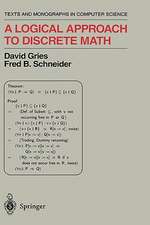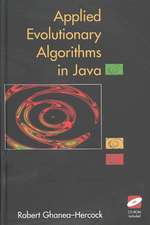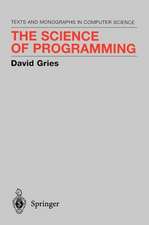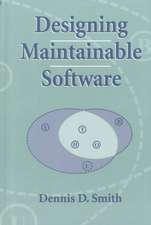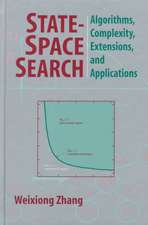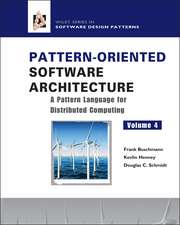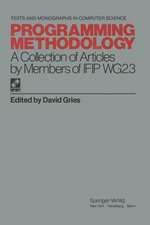Multimedia Introduction to Programming Using Java
Autor David Gries, Paul Griesen Limba Engleză Paperback – 9 sep 2004
Multimedia Introduction to Programming Using Java anchors its pedagogy in the program ProgramLive that you may find at extras.springer.com, a complete multimedia module in itself. Containing over 250 recorded lectures with synchronized animation, ProgramLive allows users to see, first-hand and in real time, processes like stepwise refinement of algorithms, development of loops, execution of method calls and associated changes to the call stack, and much more. The zip file also includes all programs from the book, 35 guided instruction sets for closed lab sessions, and a 70-page hyperlinked glossary.
Additional key features of this work:
Provides clear and accessible treatment of all aspects of a first course, along with more advanced topics such as recursion, exceptions, interfaces, inner classes, and GUIs.
Introduces objects and classes early in the exposition, rendering object-oriented programming intuitive and natural.
Develops programs, rather than simply showcasing them.
Supports all concepts through complementary lectures on the zip-file featured on extras.springer.com.
Contains numerous self-help exercises that encourage readers to practice programming.
Emphasizes rigor and accuracy through user-friendly exposition and a flexible organizational style.
With its comprehensive appendices and bibliography, systematic approach, and helpful interactive programs onextras.springer.com, this exciting work provides the key tools they needed for successful object-oriented programming. It is ideal for use at the undergraduate and graduate beginning level, whether in the classroom or for distance learning; furthermore, the text will also be a valuable self-study resource or reference volume in any programmer’s library.
Preț: 350.21 lei
Preț vechi: 437.76 lei
-20% Nou
Puncte Express: 525
Preț estimativ în valută:
67.02€ • 69.71$ • 55.33£
67.02€ • 69.71$ • 55.33£
Carte tipărită la comandă
Livrare economică 14-28 aprilie
Preluare comenzi: 021 569.72.76
Specificații
ISBN-13: 9780387226811
ISBN-10: 0387226818
Pagini: 536
Ilustrații: XVIII, 536 p. 420 illus.
Dimensiuni: 178 x 254 x 26 mm
Greutate: 0.91 kg
Ediția:2005
Editura: Springer
Colecția Springer
Locul publicării:New York, NY, United States
ISBN-10: 0387226818
Pagini: 536
Ilustrații: XVIII, 536 p. 420 illus.
Dimensiuni: 178 x 254 x 26 mm
Greutate: 0.91 kg
Ediția:2005
Editura: Springer
Colecția Springer
Locul publicării:New York, NY, United States
Public țintă
Professional/practitionerCuprins
Basic Object-Oriented Programming.- Computers and Programming.- Object-Oriented Introduction to Java.- Methods.- Classes.- Subclasses.- Some Useful Classes.- Reference on Primitive Types.- Other Java Constructs.- Loops.- Arrays.- Multi-dimensional Arrays.- Exception Handling.- Packages.- Interfaces and Nested Classes.- Aspects of Programming.- Programming Style.- Testing and Debugging.- Recursion.- Applications and Applets.- GUIs.
Recenzii
From the reviews of the first edition:
"I would like to express my enthusiasm reading this excellent text on programming with Java. … I would like to emphasize that this book is comprehensive, conceptually and methodically up-to-date, its content is both rigorously and clearly written. It is obvious that one of the authors’ aims was to supply a easy learning textbook in this respect; this is the reason, why the book benefits, among other facilities, by a rather useful multimedia support on programming in Java." (Tudor Balanescu, Zentralblatt MATH, Vol. 1082, 2006)
"I would like to express my enthusiasm reading this excellent text on programming with Java. … I would like to emphasize that this book is comprehensive, conceptually and methodically up-to-date, its content is both rigorously and clearly written. It is obvious that one of the authors’ aims was to supply a easy learning textbook in this respect; this is the reason, why the book benefits, among other facilities, by a rather useful multimedia support on programming in Java." (Tudor Balanescu, Zentralblatt MATH, Vol. 1082, 2006)
Textul de pe ultima copertă
Although vital to modern software development, Java and object-oriented programming can pose significant challenges to newcomers. This text, unique in both scope and approach and accompanied by interactive content that you may find on extras.springer.com, addresses that learning curve by providing a careful, classroom-tested presentation of Java -- from the fundamentals of variables, types, and expressions to procedural concepts like loops and sophisticated object-oriented ideas.
Multimedia Introduction to Programming Using Java anchors its pedagogy in the program ProgramLive that you may find at extras.springer.com, a complete multimedia module in itself. Containing over 250 recorded lectures with synchronized animation, ProgramLive allows users to see, first-hand and in real time, processes like stepwise refinement of algorithms, development of loops, execution of method calls and associated changes to the call stack, and much more. The zip file also includes all programs from the book, 35 guided instruction sets for closed lab sessions, and a 70-page hyperlinked glossary.
Additional key features of this work:
Provides clear and accessible treatment of all aspects of a first course, along with more advanced topics such as recursion, exceptions, interfaces, inner classes, and GUIs.
Introduces objects and classes early in the exposition, rendering object-oriented programming intuitive and natural.
Develops programs, rather than simply showcasing them.
Supports all concepts through complementary lectures on the zip-file featured on extras.springer.com.
Contains numerous self-help exercises that encourage readers to practice programming.
Emphasizes rigor and accuracy through user-friendly exposition and a flexible organizational style.
With its comprehensive appendices and bibliography, systematic approach, and helpful interactive programs onextras.springer.com, this exciting work provides the key tools they needed for successful object-oriented programming. It is ideal for use at the undergraduate and graduate beginning level, whether in the classroom or for distance learning; furthermore, the text will also be a valuable self-study resource or reference volume in any programmer’s library.
Multimedia Introduction to Programming Using Java anchors its pedagogy in the program ProgramLive that you may find at extras.springer.com, a complete multimedia module in itself. Containing over 250 recorded lectures with synchronized animation, ProgramLive allows users to see, first-hand and in real time, processes like stepwise refinement of algorithms, development of loops, execution of method calls and associated changes to the call stack, and much more. The zip file also includes all programs from the book, 35 guided instruction sets for closed lab sessions, and a 70-page hyperlinked glossary.
Additional key features of this work:
Provides clear and accessible treatment of all aspects of a first course, along with more advanced topics such as recursion, exceptions, interfaces, inner classes, and GUIs.
Introduces objects and classes early in the exposition, rendering object-oriented programming intuitive and natural.
Develops programs, rather than simply showcasing them.
Supports all concepts through complementary lectures on the zip-file featured on extras.springer.com.
Contains numerous self-help exercises that encourage readers to practice programming.
Emphasizes rigor and accuracy through user-friendly exposition and a flexible organizational style.
With its comprehensive appendices and bibliography, systematic approach, and helpful interactive programs onextras.springer.com, this exciting work provides the key tools they needed for successful object-oriented programming. It is ideal for use at the undergraduate and graduate beginning level, whether in the classroom or for distance learning; furthermore, the text will also be a valuable self-study resource or reference volume in any programmer’s library.
Caracteristici
Content on Springer Extras contain over 250 recorded lectures with synchronized animation, programs for the book, 35 guided instruction sets for closed lab sessions, and a 70-page hyperlinked glossary Provides clear and accessible treatment of all aspects of a first course, along with more advanced topics such as recursion, exceptions, interfaces, inner classes, and GUIs Develops programs, rather than simply showcasing them Contains numerous self-help exercises that encourage readers to practice programming Ideal for classroom use and for distance learning, the text will also be valuable as a self-study resource or a reference volume in any programmer’s library Includes supplementary material: sn.pub/extras



